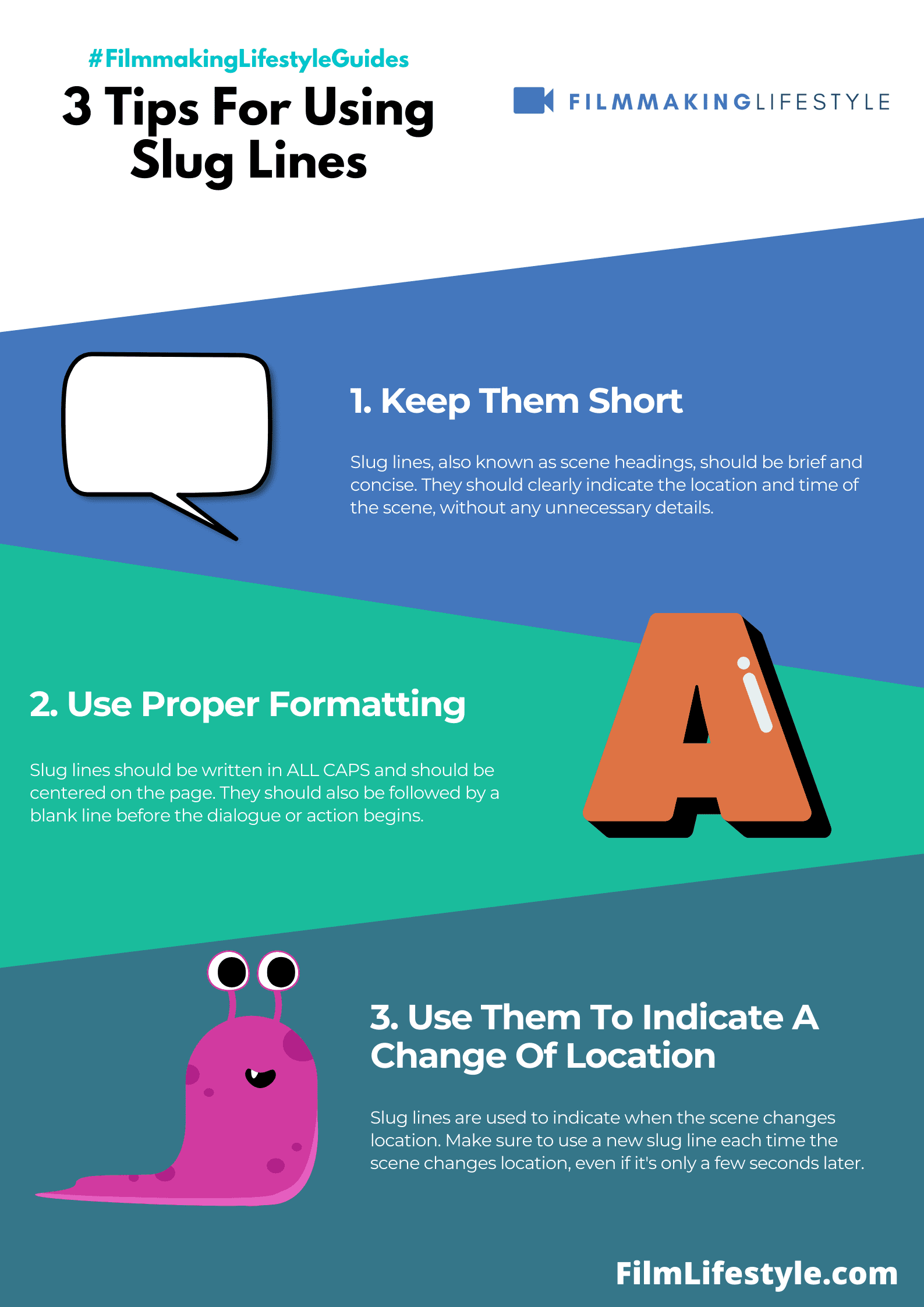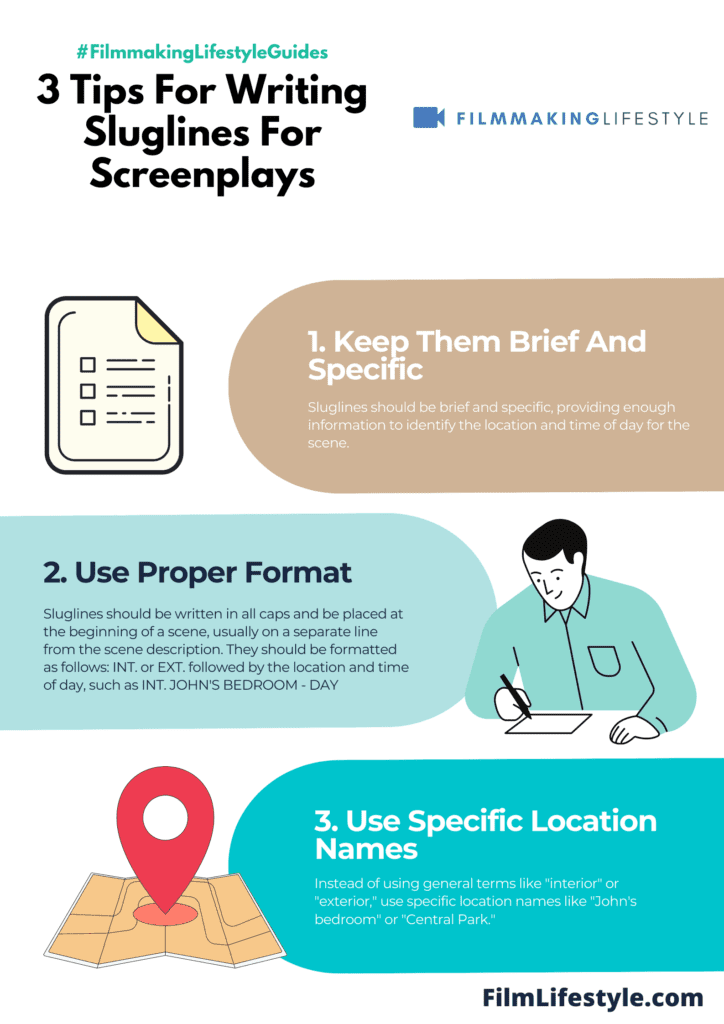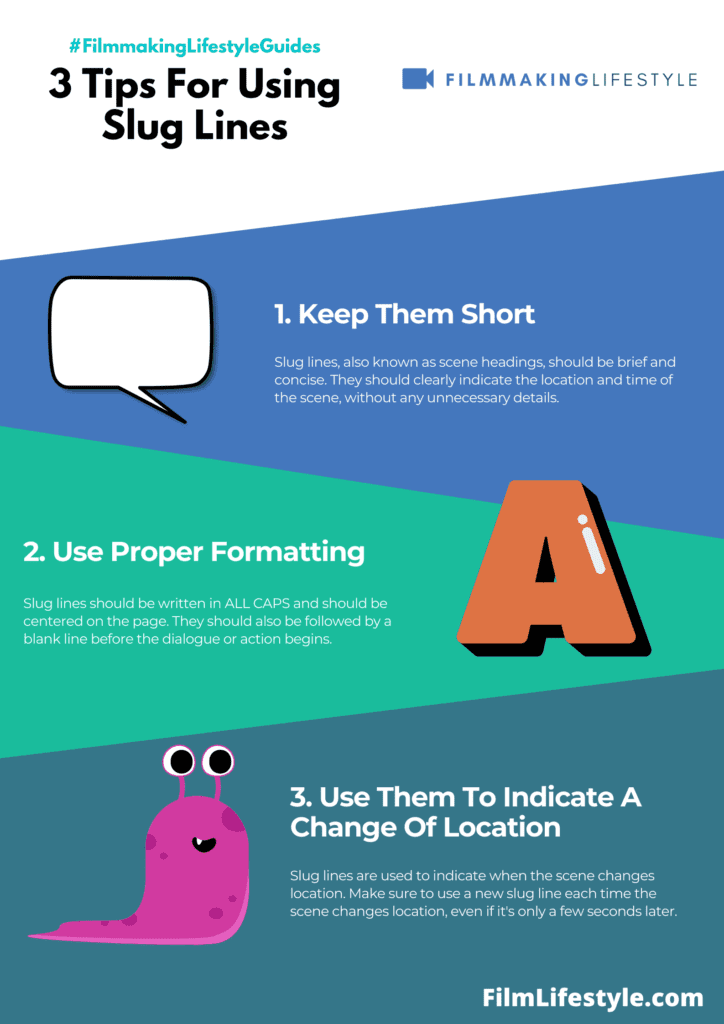A slugline is an identifying mark that tells you where the story can be found.
‘The,’ even if it’s not part of the headline, which means that it will always be at the top of any page on which it appears. You might see something like this: “The meeting was called for 10 AM.”
HOW TO WRITE SLUGLINES
What Are Sluglines?
Sluglines are used to identify important information in a story. Sluglines typically include the date, location, and a brief summary of what the piece of writing (in our case here, a screenplay) is about.
The term “slug” is derived from the word “slugger,” which means to hit someone or something hard with your fist.
The name came about when editors would use slugs (a lead-weighted metal object) to pound type into place at the end of columns in newspaper print shops.
In the world of screenwriting, mastering the art of sluglines is crucial for setting the stage.
They’re the unsung heroes that anchor our scenes, guiding readers through our story’s journey.
We’ll jump into the nitty-gritty of crafting effective sluglines, ensuring your script’s locations and transitions are crystal clear.
Stick with us to learn how to sharpen your screenwriting skills and captivate your audience from the very first line.
The Importance Of Sluglines In A Screenplay
Sluglines, often undervalued, are a screenplay’s navigational tools.
They direct the reader’s imagination, pinpointing where and when a scene takes place.
With the diligence of a painter setting their canvas, screenwriters must employ sluglines to construct their visual framework.
Within sluglines lie the essence of spatial and temporal clarity.
A well-crafted slugline prevents readers from being disoriented, ensuring a scene’s location and time are immediately understood.
Master the use of sluglines, and we ensure scenes unfold seamlessly in the reader’s mind.
Perfectly placed sluglines serve as the backbone for a screenplay’s pacing and rhythm.
Each transition from one location to another is heralded by these crucial lines, setting the tempo for the unfolding drama.
Let’s not forget, the specifics laid out in a slugline can point to underlying themes or character arcs.
In The Godfather, the transition from the warm, intimate wedding to the cold, sterile office illustrates a world divided.
Here, choices have consequences, and sluglines subtly communicate this.
Our task as screenwriters includes creating a visual journey for our audience.
We achieve this through the precise use of sluglines, So shaping the storyboard in the reader’s mind before a single frame is shot.
It’s this level of detail that can elevate our scripts from good to great.
Powerful sluglines can even influence the production design and cinematography of a film.
These brief yet potent lines offer the first glimpse into the world we’re creating, guiding the creative team in bringing each scene to life.
Through sluglines, we lay the foundation for the visual storytelling that captivates audiences.
Remember:
- Clarity and precision in sluglines are
paramount . - They act as signposts, guiding the pacing of the narrative.
- Effective sluglines influence both the written script and the final film.
Our goal is to provide a map of our story’s world with sluglines, ensuring that every reader can traverse our narrative landscape with ease.
By mastering the art of sluglines, we not only streamline the script for readers but also for the filmmakers who bring our words to life.
Anatomy Of A Slugline
Writing sluglines is a fundamental skill in screenwriting.
These lines cue the transition from one scene to the next and often come down to fine points that can make or break a reader’s understanding of where and when a scene takes place.
The structure of a slugline is intentionally straightforward.
It typically consists of three elements – INT.
or EXT.
indicating interior or exterior, the LOCATION, and the TIME of day.
When crafting a slugline, specificity is key.
Clarity and precision allow everyone from the script reader to the production crew to visualize the setting accurately.
For example, “EXT.
ABANDONED WAREHOUSE – NIGHT” gives a clear indication where the scene is set and at what time.
Here are elements that are crucial to a properly formatted slugline:
- INT./EXT. – Tells whether the action is inside or outside,
- LOCATION – Defines the specific place where the scene occurs,
- TIME – Either DAY or NIGHT traditionally, though sometimes more specific times are given.
Beyond the basics, creativity in sluglines can enhance the storytelling.
Tools like sub-headers can add further details.
Imagine the difference in mood between “INT.
GRAND HOTEL LOBBY – DAY” and “INT.
GRAND HOTEL LOBBY – THE CLOCK STRIKES MIDNIGHT”, where the latter might set up a key story event.
Film titles like The Godfather and It’s a Wonderful Life offer great examples of sluglines that guide the viewer through their worlds.
By studying these scripts, we can see how each slugline contributes to pacing and plot development.
Let’s remember that while sluglines direct the crew, they also promise an experience to the audience.
They’re the first step in bringing the written word to life, setting the stage for the action that follows.
A well-executed slugline is the blueprint for the emotional and visual journey we’re about to take our viewers on.
Establishing Location In Sluglines
Effective sluglines anchor the audience in the story’s geography.
We must precisely inform where each scene unfolds.
Consider the opening of The Godfather.
The slugline reads EXT.
DON CORLEONE’S HOME – DAY, and instantly we’re transported.
It’s vital to invoke the essence of the space.
This shapes the mood before the first line of dialogue is spoken.
When writing sluglines, specificity is our ally.
Ambiguity can derail the narrative flow, leaving readers and viewers disoriented.
A well-crafted slugline can convey not just location but also time and context:
- INT. LAS VEGAS CASINO – NIGHT,
- EXT. LONELY HIGHWAY – DUSK,
- INT. HIGH SCHOOL LOCKER ROOM – AFTER THE GAME.
In It’s a Wonderful Life, locations like Bedford Falls and Pottersville become characters in their own right.

This is achieved through evocative sluglines that more than just set scenes – they enhance them.
Sluglines bridge the gap between script and screen.
They’re not mere labels but integral components of visual storytelling.
By stating whether the scene is inside or outside – INT.
or EXT.
– we lay the ground rules.
We then add a location and a time of day, offering a snapshot of the scene at a glance.
Location sluglines imbue the script with a sense of place, critical for immersive storytelling.
A clear location immediately sets the stage, be it gritty streets or the serene countryside.
Crafting sluglines for various settings, we must remember to:
- Be concise yet comprehensive,
- Use recognizable landmarks when relevant,
- Avoid superfluous details.
Screenplays are the blueprint from which films are built.
And in that blueprint, our sluglines work to ensure every scene is rooted in a time and place that carries the narrative forward.
In our quest to master the art of slugline writing, we continually strive to balance detail with brevity.
Keeping sluglines lean and potent allows for a clearer vision and a more streamlined production process.
Transitioning Scenes With Sluglines
When we craft a screenplay, we use sluglines to guide the audience through the story’s transitions seamlessly.
Think of them as the map that navigates viewers from scene to scene – they should be concise, yet packed with information to establish the scene’s setting.
In using sluglines to transition, there is a skill in balancing brevity with detail.
These few words set the tone, the environment, and the time of day in a single glance.
They are the launching pad for every scene, and they must be clear to prevent any confusion that could pull the audience out of the story.
Effective sluglines necessitate precise language and a keen sense of pacing.
For each transition, consider the following essentials –
- Location – Where is the scene set?
- Time – When does the scene take place?
- Time and location cues become especially crucial in scripts with complex narratives or non-linear structures. They provide clarity and coherence in films where timelines and settings shift frequently, such as in Pulp Fiction or Memento.
It’s also important to remember sluglines aren’t just functional; they’re creative elements too.
They can convey a mood or hint at an underlying theme without overtly stating it, adding layers to the narrative tapestry of the film.
A slugline might be short, but its impact on the script’s readability and the final film’s clarity cannot be overstated.
So, each slugline we write is a building block, creating the world scene by scene.
They’re not merely technical necessities; they’re opportunities for us to enhance the visual storytelling, adding depth and dimension to the cinematic experience.
With deliberate crafting, our sluglines can do more than transition – they can transform.
Tips For Writing Effective Sluglines
When crafting a screenplay, it’s easy to overlook the humble slugline, yet its impact on the reader’s understanding of your world is massive.
We’ve compiled some surefire tips to ensure your sluglines immediately immerse the reader in your cinematic vision.
Be Precise, Yet Succinct.
Every word counts in a slugline.
It’s our goal to provide just enough detail to set the scene without overwhelming the reader with unnecessary information.
Use Active Voice.
Active voice keeps the action moving forward and aligns with the dynamic nature of film.
By doing so, we create a sense of immediacy and urgency that mirrors the visual experience.
Incorporate Visually Descriptive Language.
We rely on evocative language to paint a picture that words alone can’t fully capture.
The Shawshank Redemption showcases this beautifully, with sluglines that make the scenes come alive in the reader’s mind.
Funny, Funny Thief River – an example of a slugline from a screenplay that provides both the location & a hint of the scene’s tone.
This unassuming line effectively sets up expectations and engrosses us in the story’s environment.
Include the Necessary Components –
- location – time of day.
We adhere to this standard to maintain clarity and continuity throughout our work.
Vary Your Approach.
We aren’t limited to a one-size-fits-all formula; every scene could require a different touch.
Pacing and rhythm are as crucial in writing as they are in film, and we use sluglines to control them, much like a conductor with an orchestra.
Remember, Your Slugline is the First Impression.
It’s the bridge between the script and the screen, guiding the reader and, eventually, the audience, into each new chapter of your story.
Films like Inception leverage this to lead us seamlessly from one intricate layer to another.
Avoid Technical Jargon.
We keep it simple and jargon-free to ensure that our sluglines are accessible to everyone involved in the production, from producers to production assistants.
Stay True to Your Style.
While it’s important to adhere to these guidelines, we also celebrate individuality.
Each writer has a unique voice, and that’s something we respect and encourage in every slugline we craft.
How To Write Sluglines In A Screenplay – Wrap Up
Mastering sluglines is a craft that can elevate our screenwriting to new heights.
By keeping them tight and to the point we ensure every scene begins with a punch.
We’ve shared our best practices—now it’s up to you to bring scenes to life with sluglines that are as compelling as the action that follows.
Remember the power of a well-crafted slugline lies in its ability to transport readers right into the heart of the story.
Let’s make our first impressions count and set the stage for a screenplay that’s impossible to put down.
Frequently Asked Questions
What Is A Slugline In Screenwriting?
A slugline, in screenwriting, is a line that specifies the setting of the next scene, including the location, time, and whether it’s interior or exterior.
How Important Are Sluglines?
Sluglines are crucial as they provide quick, essential details about a scene’s setting, making them the bridge between the script and the screen.
What Should A Slugline Include?
A slugline should include the location of the scene, whether it’s inside (INT.
) or outside (EXT.
), and the time of day, aligning with script formatting conventions.
Why Does Every Word Count In A Slugline?
Every word in a slugline counts because screenwriting is a form of storytelling that requires brevity and precision to effectively communicate the visual elements of a scene.
Should Sluglines Use Active Or Passive Voice?
Sluglines should use active voice as it creates a sense of immediacy, making the scene more engaging for the reader.
Can I Use Technical Jargon In Sluglines?
Avoid using technical jargon in sluglines to keep them accessible and straightforward for all readers involved in the production.
Is It Acceptable To Vary Sluglines Between Scenes?
Yes, varying sluglines based on the requirements of each scene is encouraged to more effectively convey the scene’s unique aspects.
How Can A Slugline Influence The First Impression Of A Scene?
The slugline is often the first element read for each scene, setting the tone and context, and hence, it can greatly influence the reader’s initial impression.
Matt Crawford
Related posts
2 Comments
Leave a Reply Cancel reply
This site uses Akismet to reduce spam. Learn how your comment data is processed.





I admire your blog, it has of lot of information. You just got a perennial visitor for your site.
Appreciate it, George.